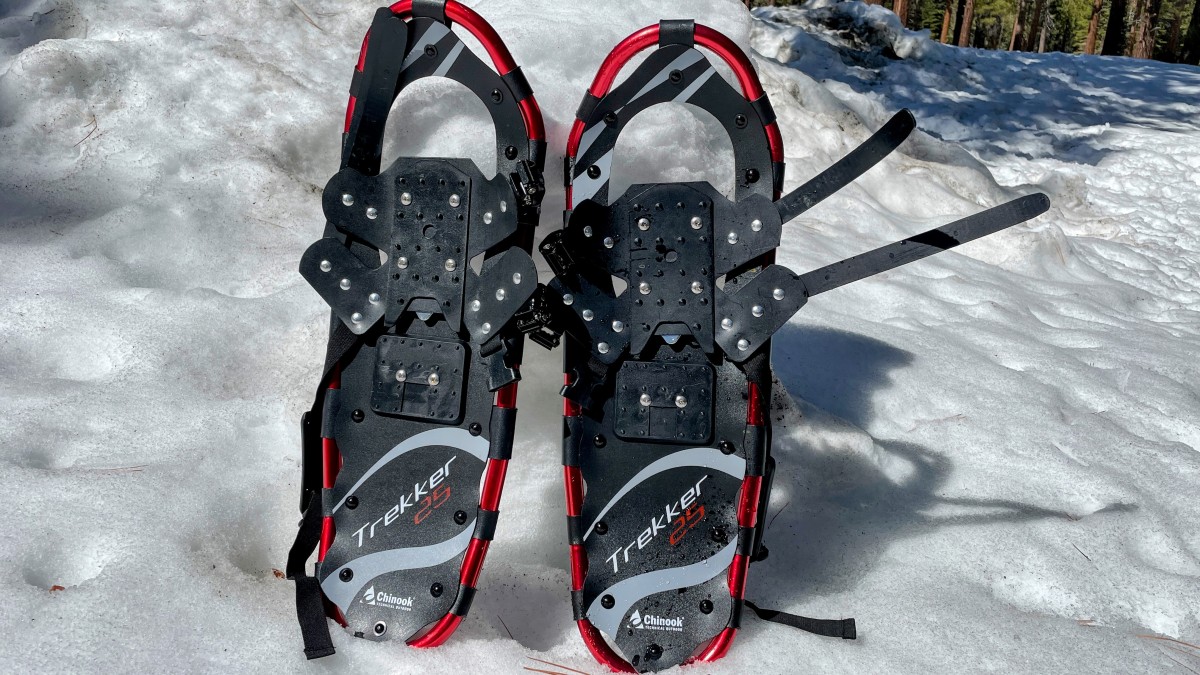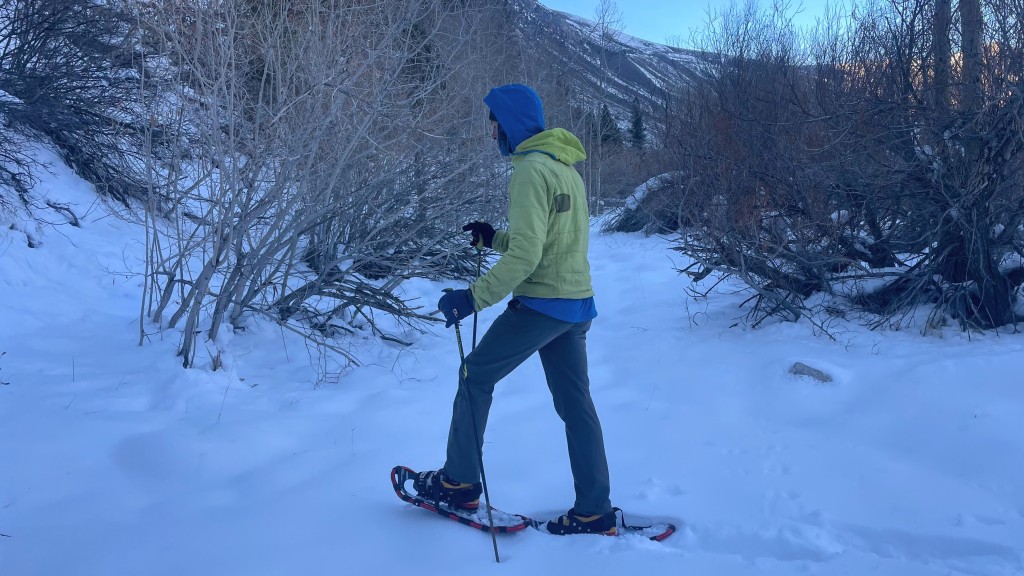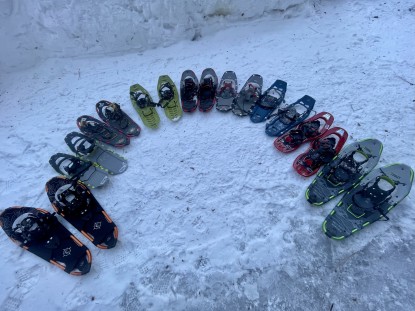Our Verdict
Compare to Similar Products
 This Product
Chinook Trekker | |||||
|---|---|---|---|---|---|
| Awards | High Performance Affordability | Best on A Tight Budget | |||
| Price | $116 List $102.74 at Amazon | $169.95 at REI Compare at 3 sellers | $115.00 at Amazon | Check Price at Amazon | $97.00 at Amazon |
Overall Score  |
|||||
| Star Rating | |||||
| Bottom Line | These unimpressive snowshoes can be a great value for hikers who won't be asking much of them | This reliable and well-priced snowshoe is versatile and easy to use | Though they're not for steep or deep snow, these inexpensive pair do well on simple and short hikes | Most cheap snowshoes have poor bindings, but we found the G2 to be comfy and secure | While they're not great in mountainous terrain or deep snow, the price is right |
| Rating Categories | Chinook Trekker | MSR Evo Trail | Tubbs Xplore | G2 Ratchet Binding | Tubbs Flex STP |
| Flotation (30%) | |||||
| Traction (30%) | |||||
| Walkability (20%) | |||||
| Bindings (20%) | |||||
| Specs | Chinook Trekker | MSR Evo Trail | Tubbs Xplore | G2 Ratchet Binding | Tubbs Flex STP |
| Measured Weight (per pair) | 4.2 lbs | 3.7 lbs | 3.6 lbs | 4.5 lbs | 3.5 lbs |
| Sizes Available | 22", 25", 30", 36" | 22" (one size) | 25", 30" | 22", 25", 30", 36" | 24", 28" |
| Binding System | Ratchet straps with plastic buckles, nylon strap with ladder-lock buckle | Rubber net and straps with pin-in-hole | Quickpull Nylon and rubber straps | Ratchet straps with plastic buckles, EVA padding, rubber tension straps | Quickpull Nylon and rubber straps |
| Frame Material | Aluminum | Plastic and steel | Aluminum | Aluminum | Plastic and steel |
| Measured Surface Area | 205 sq in | 183 sq in | 198 sq in | 225 sq in | 182 sq in |
| Measured Dimensions | 25"L x 8"W | 24"L x 8"W | 26"L x 8"W | 31"L x 9"W | 25"L x 8"W |
| Binding/Deck Connection | Strapped | Hinged | Hybrid hinged and strapped | Hinged | Hinged |
| Crampon/Traction Aids | Aluminum crampons and teeth | Steel crampons and rails | Steel crampons and teeth | Aluminum crampons and teeth | Steel crampons and rails |
| Deck Material | Polyethylene fabric | Polypropylene | Soft-Tec PVC-coated polyester | Polyethylene fabric | Torsion Deck (plastic) |
| Heel Lift | No | No | No | Yes | No |
| Flotation Tails Sold Separately? | No | Yes | No | No | No |
| Men's and Women's Versions? | Unisex | Unisex | Yes | Unisex | Yes |
| Optimum Weight Load (per manufacturer) | 90-130 lbs (size 22") 130-210 lbs (size 25") 180-250 lbs (size 30") 250-300 lbs (size 36") |
up to 180 lbs | 120-200 lbs (size 25") 170-250 lbs (size 30") 220-300 lbs (size 36") |
up to 150 lbs (size 21") up to 200 lbs (size 25") up to 250 lbs (size 30") up to 300 lbs (size 36") |
80-160 lbs (size 22") 120-200 lbs (size 24") over 190 lbs (size 28") |
| Tested Size | 25" | 22" | 25" | 30" | 24" |
Our Analysis and Test Results
The most important job of a snowshoe, indeed its raison d'etre, is to keep you from post-holing. The Chinook Trekker does this. When kept on the mellow terrain it's designed for, it performs adequately. Bottom line: the Trekker is a screaming deal, but that low price comes with some trade-offs.
Performance Comparison
Flotation
Flotation is one of the most important qualities of a snowshoe, which is why we cover it first. The Trekker boasts great flotation for a 25-inch long snowshoe — its 205 square inches of surface area rise above many of the other 25-inch options we tested.
This good float is due, for the most part, to the shape of the snowshoe, which has much less taper than the competition. Decks that taper towards the tail make for easier walking but reduce flotation. It's also slightly aided by the deck material. Though the Trekker is made from flexible polyethylene plastic, it's still stiffer than the fabric found on other models.
Traction
Traction is not a strong suit for the Trekker. We found ourselves spending a lot of brainpower avoiding slips and slides any time these snowshoes were pointed uphill. Hikes we had done easily with other models in this review felt more daunting with this one.
The crampon on the Trekker is made of aluminum. All of the competing models in our review use steel crampons. Aluminum is softer than steel and dulls faster, so keep these snowshoes away from rocks. The cleat under the heel is pretty modest when compared to others as well. We noticed this most on downhills with crusty snow. This led to a few spills and resulted in some of our testers shuffle-stepping down steep or exposed slopes. Steep terrain is not what the budget Trekker was made for. Stick to flat or gently rolling ground and be aware of your surroundings when hiking on a melt-freeze spring snowpack, which can be surprisingly crusty and slippery.
Walkability
The Chinook Trekker is right in the middle of the pack when it comes to walking comfort. The shape has only a very minor taper towards the tail. While this enhances flotation, the cost is a sometimes awkward stride. As long as we kept that in mind and stayed on moderate trails or groomed roads, this didn't seem to be too much of a problem. On steeper terrain or in places where we wanted to be more precise, that shape was somewhat of a liability.
The binding-to-deck connection is managed by a flexible strap. Among the models with this particular design, the Trekker is one of the most natural to walk in. The strapped setup provides a little more give and cushion than a hinge but at the cost of precision on technical terrain. Hikers who are heading into the mountains in the winter should consider models that feature a hinged binding-to-deck linkage which is much more precise. The Trekker also does not have a heel lifter. This feature is found on other models designed for steep or technical terrain. Its absence here is another reminder that this model is not built for that kind of winter travel.
Bindings
The Trekker is moderately easy to put on. Inserting the end of the ratchet strap into the buckle is a little finicky each time, but once it's in there, you can achieve the desired tightness using the lever on the buckle to crank the strap down.
A smaller lever, which can be tricky to use with bulky gloves, releases the tension when it's time to take the snowshoe off. Most hikers will be familiar with the nylon webbing and ladder lock buckle configuration that comprises the heel strap. If you're using the same footwear, this strap can be left in the same setting. The bindings fold fairly flat to the deck, making the Trekker one of the easiest models to transport as they take up little space in the trunk of a compact car or a checked bag.
The bindings on the Trekker are reasonably comfortable. The forefoot straps are mounted on wider plastic “wings” that help to distribute the load around your boot. On stiff snowboard or mountaineering boots, this wasn't particularly important. For folks with softer winter footwear, this is a big advantage over the rubber strap binding system found on other models, which can act as a tourniquet when over-tightened.
It's impossible to overtighten the straps on the Trekker. A small lever on the buckle does the final tightening of each ratchet strap. When too much force is applied to that lever, it slips off the teeth of the strap by design. It's not broken, it just won't let the user apply too much force to the buckle.
The bindings on these snowshoes do not inspire confidence the way other, more technical designs do. The ratcheting strap setup was not uncommon on snowshoes even up to the mid-2000s. However, that strap type is less reliable and less durable than some of the new options, and today few pairs in our review feature this technology. The heel strap is standard nylon webbing. In cold and wet environments, this type of webbing tends to freeze and ice up. When this happens, adjusting the buckle is difficult at best.
One thing we do like about the bindings on the Trekker is that all of the buckles are on the outside of the user's foot. On many other models, the heel buckle is on the inside of the foot, where it's more likely to be caught or damaged by the other snowshoe.
Should You Buy the Chinook Trekker?
Despite their flaws, the Trekker could be great for those who won't be doing a ton of snowshoeing. If you're taking your dog on the occasional snowy hike or want to have a spare pair around for when friends are visiting, these totally get the job done without emptying your wallet. Though we don't usually give awards to products that score so low, we think this model is a great value for folks who are using snowshoes very infrequently and don't care much about performance.
What Other Snowshoes Should You Consider?
Every other snowshoe in our review can do what the Trekker can do and then some. Hikers looking for a similar low price with better performance would do well to click over to the MSR Evo Trail. Those looking for top-of-the-line action should look into the MSR Lightning Ascent, which can handle almost anything you can throw at it.
















